The majority of city councils in Ontario are governed by the Municipal Act of 2001, a framework that “recognizes municipalities as responsible local governments” with a range of powers that allows localities significant self-determination.
Under the Act, each municipality must represent its citizens, provide services to them, manage finances incoming and outgoing from local government and the infrastructure of the city.
The mayor is the designated head of council, meant to preside over council as well as be a public figure, representing the municipality as a whole, both locally and elsewhere.
For example, Kitchener has ten wards, each with its own councilor whose responsibilities are to represent citizens of their own specific ward. The council is not homogeneous, as each councilor is supposed to be the best representative of their ward and council is intended to represent the diverse viewpoints of different parts of the city.
In addition to city council meetings, city council also has standing committees meant to address specific issues in Kitchener, and councilors will be on a handful of them. Kitchener’s standing committees are Planning and Strategic Initiatives, meant to decide all public planning matters; Community and Infrastructure Services, which makes decisions about public amenities and services; and Finance and Corporate services, which considers operational, departmental and budgetary issues.
Knowing who is on which committee matters when delegating towards a specific kind of action—for example, snow clearing falls under the community and infrastructure services. Knowledge of who is on city council and what their roles are is key to strategizing political change in Kitchener.
Council is the main source of policy and bylaw creation in the City of Kitchener. They are our first point of institutional change.
City councilors are policymakers, bringing motions to council to pass either from citizens in Kitchener or other interested parties. Staff do a great deal of legwork for city councilors.
Ultimately, council decisions are voted on democratically and adopted based on a majority vote, which includes the mayor.
However, residents can also be heard on projects that directly affect them and their neighbourhoods and it’s not just council and staff who identify local issues that need to be addressed.
While the city council makes the final decision and adopts policy as a collective, individual councilors are responsible to the constituents that elected them. As they are local and live alongside the people who are meant to represent, they tend to have a more direct and personal relationship with their electorate.
Residents should get to know their ward councilor, who rely on residents to to bring forward key concerns affecting their ward.

